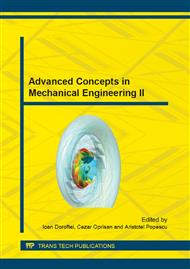p.205
p.211
p.217
p.223
p.231
p.237
p.243
p.250
p.256
COSRING-LUJET, Integrated New Concept in Automotive I.C. Engines for a Better Lubrication
Abstract:
The COSRING-LUJET is a new concept for integrated solution to improve the lubrication regime in internal combustion engines. Introducing a conical shape for the peripheral surface of the rings, the authors analyze the conditions for the lubrication regime. Under this new concept, entitled COSRING, has developed a method for determining the transversal profile of the first and the second compression ring in order to obtain a better lubrication conditions for the piston ring – cylinder line assembly. On the other hand, the authors analyze the main factors affecting the cam-follower contact conditions, emphasizing the influence of the lubrication regime conditions over the couple wear reduction. The LUJET concept, proposed and studied by the authors, is an original solution for the improvement of the lubrication regime and engine life by using additional oil jets directed over the contact area.
Info:
Periodical:
Pages:
231-236
Citation:
Online since:
October 2014
Keywords:
Price:
Сopyright:
© 2014 Trans Tech Publications Ltd. All Rights Reserved
Share:
Citation:


